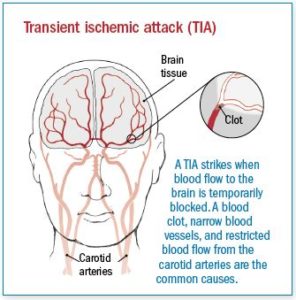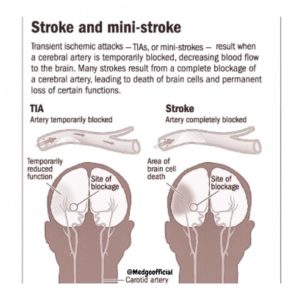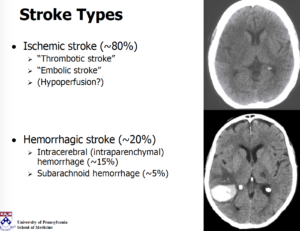
TREATMENT OF STROKES
If you’re having a stroke, it’s critical that you get medical attention right away. Immediate treatment may minimize the long-term effects of a stroke and prevent death!
Ischemic Stroke Treatment
tPA, the Gold Standard
The only FDA approved treatment for ischemic strokes is tissue plasminogen activator (tPA, also known as IV rtPA, given through an IV in the arm). tPA works by dissolving the clot and improving blood flow to the part of the brain being deprived of blood flow. If administered within 3 hours(and up to 4.5 hours in certain eligible patients), tPA may improve the chances of recovering from a stroke. A significant number of stroke victims don’t get to the hospital in time for tPA treatment; this is why it’s so important to identify a stroke immediately.
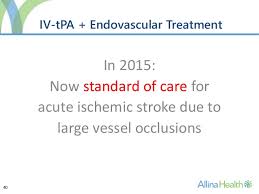
Endovascular Procedures
Another treatment option is an endovascular procedure* called mechanical thrombectomy, strongly recommended, in which trained doctors try removing a large blood clot by sending a wired-caged device called a stent retriever, to the site of the blocked blood vessel in the brain. To remove the brain clot, doctors thread a catheter through an artery in the groin up to the blocked artery in the brain. The stent opens and grabs the clot, allowing doctors to remove the stent with the trapped clot. Special suction tubes may also be used. The procedure should be done within six hours of acute stroke symptoms, and only after a patient receives tPA.
*Note: Patients must meet certain criteria to be eligible for this procedure.
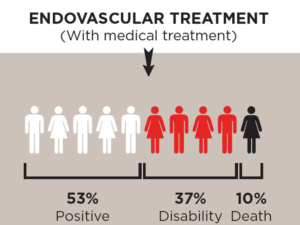
Image courtesy of Medtronic
Hemorrhagic Stroke Treatment
Endovascular Procedures
Endovascular procedures may be used to treat certain hemorrhagic strokes similar to the way the procedure is used for treating an ischemic stroke. These procedures are less invasive than surgical treatments, and involve the use of a catheter introduced through a major artery in the leg or arm, then guided to the aneurysm or AVM; it then deposits a mechanical agent, such as a coil, to prevent rupture.
Surgical Treatment
For strokes caused by a bleed within the brain (hemorrhagic stroke), or by an abnormal tangle of blood vessels (AVM), surgical treatment may be done to stop the bleeding. If the bleed is caused by a ruptured aneurysm (swelling of the vessel that breaks), a metal clip may be placed surgically at the base of the aneurysm to secure it.
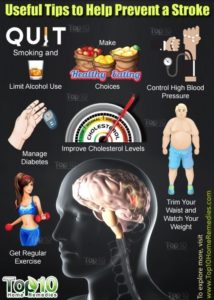
How to prevent a stroke!
Treatment is also aimed at other factors that put you at risk, including high blood pressure, diabetes, and high cholesterol. But it takes more than just your doctor’s efforts. You also have an important role to play in preventing stroke. It’s up to you to make lifestyle changes that can lower your risk.
What you can do to prevent a stroke is this:
1-Control your blood pressure.
2-Lose Weight to the point that your in a healthy weight for your height. If you’re overweight, losing as little as 10 pounds can have a real impact on your stroke risk. Try to eat no more than 1,500 to 2,000 calories a day (depending on your activity level and your current body mass index). Increase the amount of exercise you do with such activities as walking, golfing, or playing tennis, and by making activity part of every single day.
3-Exercise More-Exercise contributes to losing weight and lowering blood pressure, but it also stands on its own as an independent stroke reducer. Exercise at a moderate intensity 5x/wk and if you can’t do ½ hr as day spread it out into 2 15minute exercise moments for the day.
4- Drink-in moderation What you’ve heard is true. Drinking can make you less likely to have a stroke—up to a point. “Studies show that if you have about one drink per day, your risk may be lower. I am not saying drink one glass of liquor a day but if you have to limit it to one glass a day. Red wine your first choice, because it contains resveratrol, which is thought to protect the heart and brain.
5-Atrial Fibrillation-Atrial fibrillation is a form of irregular heartbeat that causes clots to form in the heart. Those clots can then travel to the brain, producing a stroke. “Atrial fibrillation carries almost a fivefold risk of stroke, and should be taken seriously; take your anticoagulant medication the MD orders to keep the blood thin to prevent clotting.
6-Treat diabetes –Having high blood sugar over time damages blood vessels, making clots more likely to form inside them putting the person at higher risk for a stroke. So simply keep your sugar under control.
7-QUIT Smoking-Along with a healthy diet and regular exercise, smoking cessation is one of the most powerful lifestyle changes that will help you reduce your stroke risk




